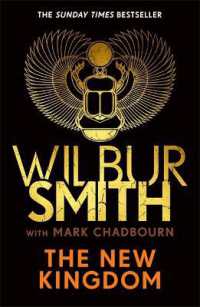- ホーム
- > 洋書
- > 英文書
- > History / World
Full Description
1. The Emergence of warrior societies and its economic, social and environmental consequences. Proceedings of the XVII UISPP World Congress (1-7 September 2014, Burgos, Spain) Session A3c edited by Fernando Coimbra and Davide Delfino: Several works have been dedicated to the aim of warfare in European Bronze Age, by a point of view of bronze technology and archaeometallurgy. The present volume wants to be a short and actualized contribution to the study and interpretation of warrior societies, through a point of view of the marks of the first warfare in Europe, its causes and its consequences in all the intelligible evidences, both from a point of view of material culture, of landscape, of human behavior and artistic manifestations. 2. Aegean - Mediterranean imports and influences in the graves from continental Europe - Bronze and Iron Ages. Proceedings of the XVII UISPP World Congress (1-7 September 2014, Burgos, Spain) Session A16a edited by Valeriu Sîrbu and Cristian Schuster: There is already a 'history' with not only different, but sometimes contradictory opinions regarding the role played by the Aegean-Mediterranean area in the evolution of the peoples who lived in continental Europe during the age of Bronze and Iron, including burial customs. The organizers of this session proposed, through ongoing communication and the discussions that followed, to obtain new data on the influences and Aegean-Mediterranean imports found in the graves, and the possible movements of groups of people who carried them. The main area of interest focused on the 'roads' and the stages of their penetration, but also considered feedback from peripheral areas. The session aims to highlight the role of the southern imports in the evolution of local communities' elites and their impact on the general development of the populations of continental Europe, the possible meanings of their deposit in the burials. Analysis of these phenomena over wide geographical areas (from the Urals to the Atlantic) and large chronological periods (the third-. first millennia BC) allow the identification of certain traits as general (eg., the continuity and discontinuity), or particular (eg., the impact of imports and southern influences on communities of different geographical areas).
Contents
Foreword to the XVII UISPP Congress Proceedings Series Edition (Luiz Oosterbeek); Introduction - 1. The Emergence of warrior societies and its economic, social and environmental consequences (Fernando Coimbra and Davide Delfino); Introduction - 2. Aegean - Mediterranean imports and influences in the graves from continental Europe - Bronze and Iron Ages (Valeriu Sîrbu and Cristian Schuster); 1. The Emergence of warrior societies and its economic, social and environmental consequences: Walled enclosures in Western Europe as marks of conflict in Late Prehistory. A psychological, anthropological and archaeological approach (Davide Delfino); Symbols for protection in war among European societies (1000 BC - 1000 AD) (Fernando Coimbra); The emergence of war in human societies (Gabriele L. F. Berruti and Stefano Ruzza); The Bronze Age battlefield in the Tollense Valley, Mecklenburg-Western Pomerania, Northeast Germany - Combat marks on human bones as evidence of early warrior societies in northern Middle Europe? (Ute Brinker, Annemarie Schramm, Detlef Jantzen, Jurgen Piek, Karlheinz Hauenstein and Jorg Orschiedt); The Late Bronze Age two-piece cuirasses of the Danube region in the Carpathian Basin (Katalin Jankovits); Warfare in Valcamonica rock art, new emerging data from Paspardo area (Dario Sigari); Model of metalwork and scrap's bronze circulation during Late Bronze Age in the Middle Tagus (Davide Delfino); Settlements and Houses in Galicia in the Middle and Late Bronze Age (M. Pilar Prieto-Martínez and Mikel Díaz-Rodríguez); From the regional to the extra-regional: Wide Horizontal Rim vessels and stamping in the second half of the second millennium BC in the NW Iberian Peninsula (Laure Nonat, M. Pilar Prieto-Martínez and Pablo Vázquez); 2. Aegean - Mediterranean imports and influences in the graves from continental Europe - Bronze and Iron Ages: About the connections during the Bronze Age between the Carpatho-Danubian area and the Eastern Mediterranean space. Possible funerary proves (Cristian Schuster); Middle Tagus Region and the Autochthonous evidences in Late Bronze Age I (Central Portugal) (Ana Cruz); Southern and Pontic Amphorae Found in Several Getae Necropolises in the Lower Danube Area (5th-3th c. BC) (Valeriu Sîrbu and Sebastian Matei); The Southern Group of Tumuli of the Eastern Necropolis in the Sboryanovo reserve. Greek Amphorae and a Getic Royal burial (Diana Gergova); Early-Hellenistic barrel-vaulted tombs from Kallatis (Maria-Magdalena Ștefan and Valeriu Sîrbu)








